QuakeCon Dishonored Demo
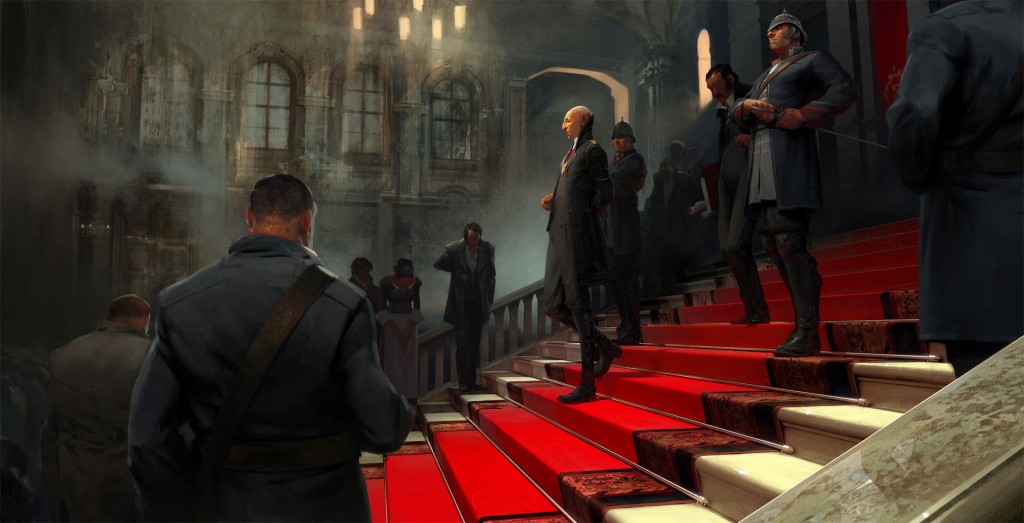 If you aren’t familiar with Dishonored, that’s all right because I wasn’t either. All I knew heading into my QuakeCon demo was that it was a first-person shooter from Arkane Studios and there may or may not be rats. While both of those things are true, there is a whole lot more to Dishonored that just Schrödinger critters.
If you aren’t familiar with Dishonored, that’s all right because I wasn’t either. All I knew heading into my QuakeCon demo was that it was a first-person shooter from Arkane Studios and there may or may not be rats. While both of those things are true, there is a whole lot more to Dishonored that just Schrödinger critters.
Indeed, Dishonored is a game that takes place in the first-person perspective, but it is less of a shooter and more of a mixed action stealth game. You play as a “supernatural assassin” and are far more capable of inflicting pain than dealing with it. The natural recourse of this characteristic is stealth, and it is here in spades.
It has been most aptly described, I believe, as BioShock meets Thief meets Deus Ex meets Half-Life. When I first heard this, I thought that sounded a bit convoluted. That’s a lot of greatness to cram into one game (unless they meant it as merely the intersection of just the bad stuff from those four games, in which case oh sweet crikey). But as I watched more of Arkane’s cofounders Harvey Smith and Raphael Colantonio playing through Dishonored, I got it, and boy do I want more of it.
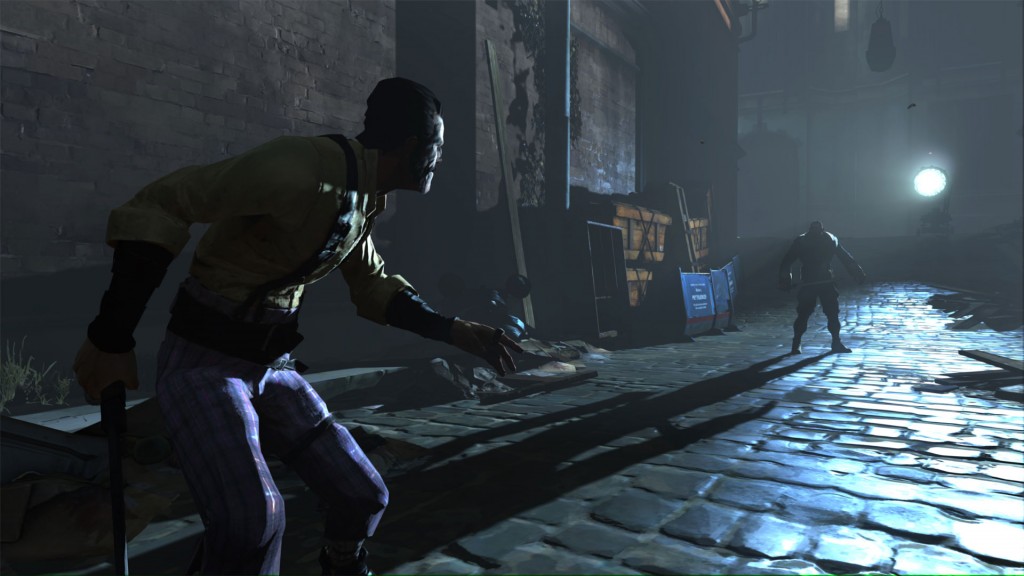 The demo starts off pretty simple with just some minor side street exploration and explanation of the game’s story and the mission’s objectives (to find and kill a lawyer). As I said before, you are a supernatural assassin, but you, as Corvo, actually used to be a bodyguard. That is until you are accused of murdering the Empress, the person you were hired to protect. Corvo claims Lord Regent framed him, but not many people are willing to buy your story. This bit of history will be explored at some point during the game, but not in this mission.
The demo starts off pretty simple with just some minor side street exploration and explanation of the game’s story and the mission’s objectives (to find and kill a lawyer). As I said before, you are a supernatural assassin, but you, as Corvo, actually used to be a bodyguard. That is until you are accused of murdering the Empress, the person you were hired to protect. Corvo claims Lord Regent framed him, but not many people are willing to buy your story. This bit of history will be explored at some point during the game, but not in this mission.
If you can’t tell by now, there is a heavy Victorian era influence on the game. I want to call it steampunk as there are some seriously modern elements to the world of Dunwall, but as not only do the developers want to avoid that label, it also seems that Dishonored doesn’t go far back enough into the retro half of the steampunk genre to make it fully fall under that banner. Generally speaking, the visuals are where I draw the largest similarities to BioShock, especially BioShock Infinite. The colors are rather vivid and there is a lot of contrast in its palette.
The game also seems to play somewhat similarly to BioShock 2. You can dual wield weapons, though your sword is always bound to your right hand whereas your left is free to brandish firearms, blades, and spells. A power wheel comes up when you want to reassign powers and weapons and looks very much like when you want to reassign your plasmids and guns in BioShock. The way button prompts for looting and contextual actions are also very similar, but I supposed there are worse things to borrow from.
We are soon shown a dead body where a bunch of rats are munching down. This offers a chance for the developers to show off some of the new lighting tech they’ve brought into the Unreal Engine and explain that the world has come under a rat plague that has killed off half its population. Rats flee from light, so once it is introduced into the scene, they scatter and we carry on.
This is where we begin to see some of the dynamic movement available to the player which definitely reminds me of playing Thief games. You can lean around corners and mantle ledges and whatnot and that rooftop access is always an option. From what I could see, though, some actions were based on controls such as press right bumper to lean or something, but others were just button presses to climb on top of this dumpster. This was never clarified as to what was and what wasn’t organic to the controls and what were contextual sequences mapped to the action button.
We proceed to come across a lone guard on the street and quickly take cover. When in hiding, white streaks will come across a certain radius of the player’s central vision and show from which direction people might be coming from and how much—if at all—they are alerted to your presence. They quickly and quietly take him down and dump his body in a nearby dumpster so as not to alert any other people who might wander by.
Walking down an alley, they spot a woman in dire need of help. Three thugs are assaulting her and Smith explains that many things like this will happen during your missions where you can choose to accept and engage in side quests or not. Whether you succeed or fail or even try or don’t will all have an impact on the mission and possibly the entire story. In this particular case, they choose to intervene and we are shown our first taste of combat.
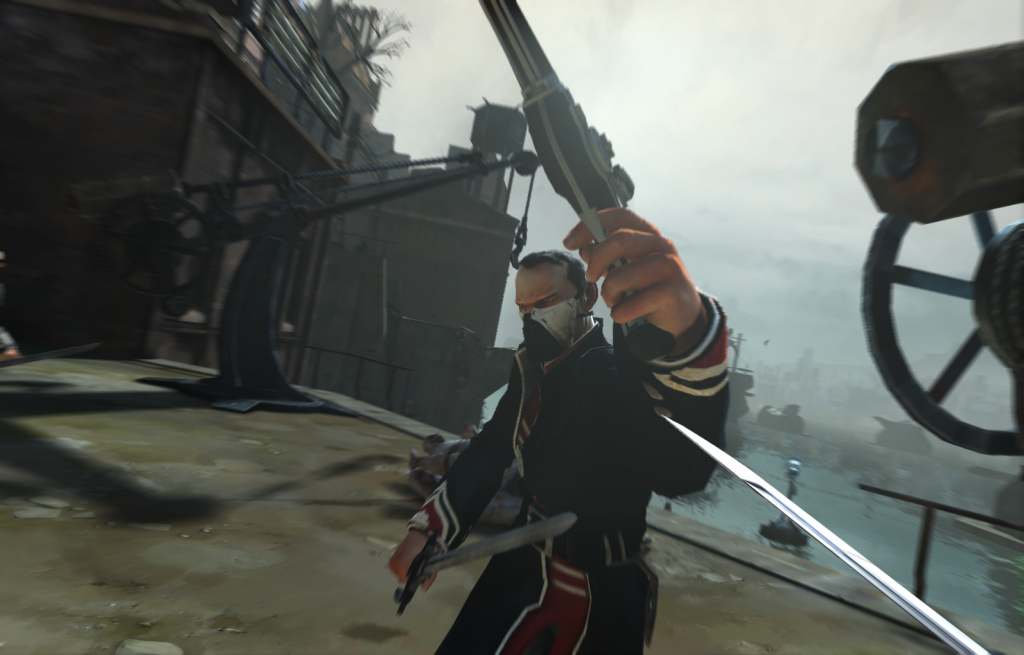 They equip a pistol and a sword and step into the alley. A fire flickers against the back wall and lights the scene nicely, providing very dramatic ambiance for the ensuing battle. As they maneuver Corvo around the enemies and take pot shots, it is immediately clear that the firearm is fairly sticky in its aiming; just come close to an enemy with the reticule and it will do its best to keep its sights trained on your foe. This, along with later action sequences and ammo provisions, gives the impression that certain encounters will definitely play out more favorably with close quarter’s weapons with the ability to parry and block enemy melee attacks whereas others are more geared towards fighting from a distance and using your powers to gain tactical advantage over entrenched enemies.
They equip a pistol and a sword and step into the alley. A fire flickers against the back wall and lights the scene nicely, providing very dramatic ambiance for the ensuing battle. As they maneuver Corvo around the enemies and take pot shots, it is immediately clear that the firearm is fairly sticky in its aiming; just come close to an enemy with the reticule and it will do its best to keep its sights trained on your foe. This, along with later action sequences and ammo provisions, gives the impression that certain encounters will definitely play out more favorably with close quarter’s weapons with the ability to parry and block enemy melee attacks whereas others are more geared towards fighting from a distance and using your powers to gain tactical advantage over entrenched enemies.
The final bad guy is dispatched with a brutal decapitation. The woman offers her thanks, but is soon devoured by a swarm of rats. What a rough day.
We then begin the task of actually breaking into the mansion with its inhabitants unaware. When hidden, a bit of text at the bottom of the screen will come up and say [hidden] so you won’t have to wonder “can he see me? He probably can’t see me…oh god he can see me!” Smith and Colantonio then explain the game’s use of “3D audio propagation.” What this means for you the player is that audio dissipates and bounces accurately across elements in the game world. So if someone is walking through a hallway ahead of you, you can tell if he is coming from the right or from the left and how far away he is from the entrance.
Corvo is then impeded by the mansion entrance. Rather than go in guns blazing (always an option) and giving the target a chance to escape, they choose to instead go stealth, but not in the way of crawling around and hiding in shadows. Instead, they show off a new power where you can possess other living creatures. In this case, they take control of a rat and crawl through an air duct and into an empty room.
They have to make it quick because this is not just mind control; this is full body inhabitance. This means that when the rat dies due to being stepped on or falling down a hole or something, you also die along with it. This also means, however, that when you cease possession of the rat, you are then wherever the rat is, hence the empty room.
After hiding from a couple more guards in some dark shadows, they discuss guard AI. The AI in this game is totally dynamic, so you can’t just count on memorizing patterns and counting down passes to get by. While I’m sure some of it is predetermined, there is also that element of randomness where a guard may meander a bit or get distracted by a painting or go warm himself up by the fire.
At this point, we’re told we’re approaching the guard with the key to the room that the lawyer is holed up in, and that if we were to fail to obtain the key, the mission could then branch of in several ways, including him running for it, having to find an alternative way in, or the mission turning into a firefight. In this case, they end up killing him and picking up the key and proceeding to the lawyer.
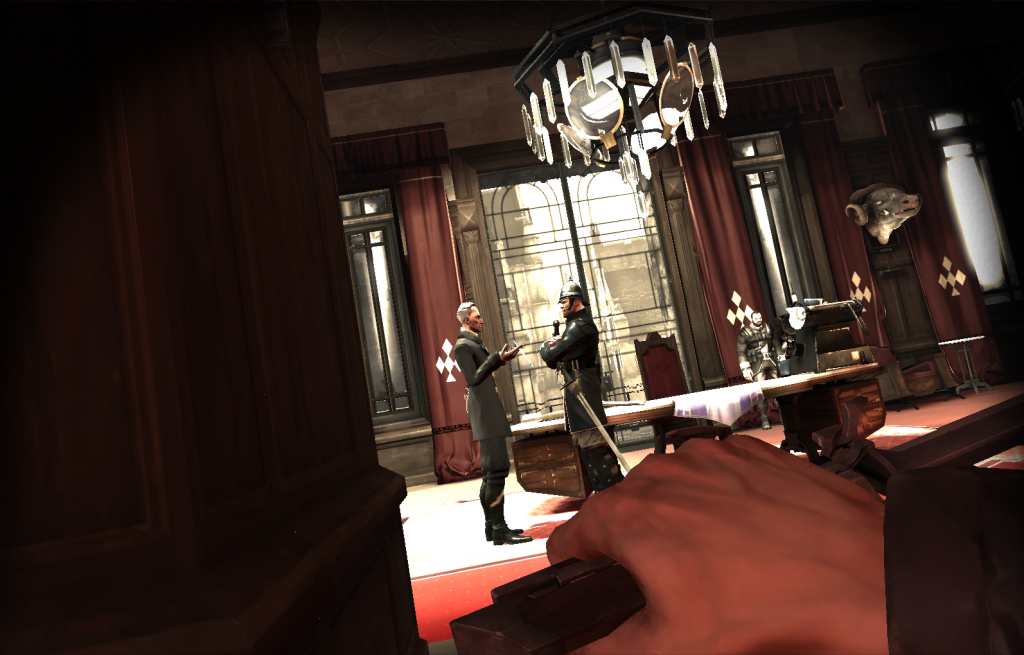 Things get physical rather quickly, but given that Corvo has several special powers at his disposal, it all ends up in his favor. First, we are shown that though the rat plague could harm the player as well, we do have the power to summon them to attack enemies. Then they use a time freeze power at which point they can freely move around the space to brutally attack the opposition at their leisure. Lastly, they use a wind blast technique that is pretty much exactly what it sounds like. It actually most reminds me of the blast powers in the Infamous series (though, to be fair, it also looks like a dozen other games with this sort of power such as Skyrim).
Things get physical rather quickly, but given that Corvo has several special powers at his disposal, it all ends up in his favor. First, we are shown that though the rat plague could harm the player as well, we do have the power to summon them to attack enemies. Then they use a time freeze power at which point they can freely move around the space to brutally attack the opposition at their leisure. Lastly, they use a wind blast technique that is pretty much exactly what it sounds like. It actually most reminds me of the blast powers in the Infamous series (though, to be fair, it also looks like a dozen other games with this sort of power such as Skyrim).
During the battle, there are a couple things are somewhat meta to the game but totally organic to the world as well. The first is a chaos meter, which is the duality gauge of the game. It is not a morality meter like other games but rather a pure reflection of your impact on the amount of chaos in the world. If you keep killing people in an exceedingly irresponsible manner and fail to hide the bodies, you will increase your chaos meter significantly. On the other hand, if you manage to remain stealthy and keep the peace in the streets, the chaos meter will begin to drain.
Based on how chaotic you are as you complete mission, the story will change. It could be as small as certain side quests or avenues to your target are not accessible or have your mission dynamically chang objectives or could be as big as changing the outcome of the entire game. Needless to say, chaos is a very large part of Dishonored.
The second part is adrenaline, the usage for which we experienced earlier in the alley with the three thugs and the woman. Adrenaline is a constantly charging resource and can be used to great effect when you find yourself in a bind during battle. We’re only shown it being used offensively (the decapitation in the alley and here with another gruesome kill in the lawyer’s office), but it may also have other uses. They never really found time to clarify in the heat of battle.
Back to the mission, though, Corvo uses a power called blink which allows him to teleport to places ahead of him and does so to get from the upper levels of the mansion where the lawyer is down to the streets where he can make an escape. Unfortunately, a siren has sounded and guards begin to descend upon our hero.
Using some more powers and some gunplay, he eventually makes it through a portion of the guards and the courtyard to his escape point, but soon comes to a slightly more open but still hostile dock area that really makes me feel like we’re in Half-Life 2’s City 17. This feeling is soon reinforced as two large Tallboys—giant bipedal robots—come into view and begin attacking. He eventually takes them and a couple additional guards down after some ingenious usage of combined powers and weapons and the demo ends.
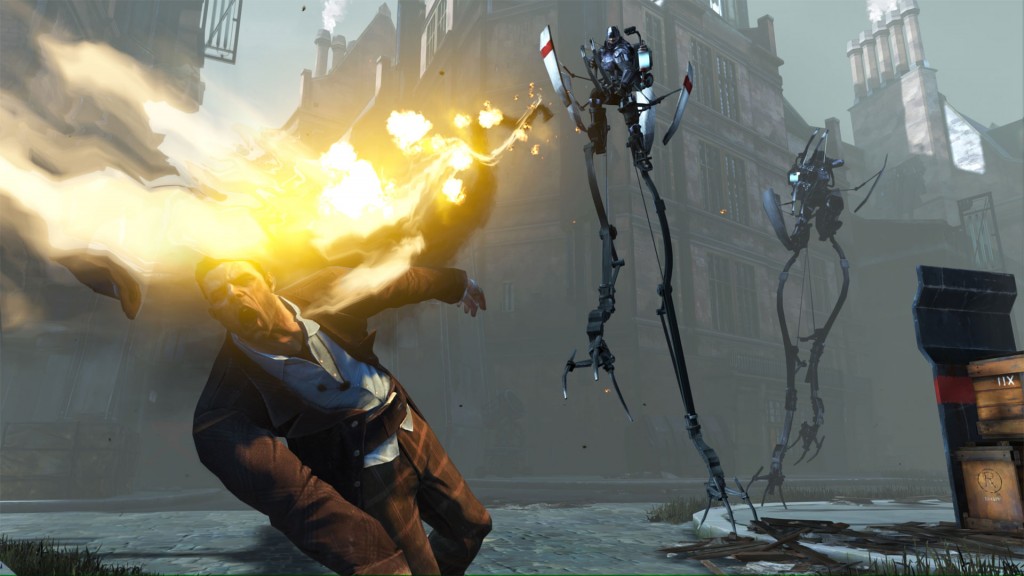 In the following Q&A, the developers point out some elements that were easy to miss or dismiss without knowing what they were. At some point during the demo inside the mansion, they had picked up a rune and some blueprints. Runes are collected and spent to upgrade and unlock new powers. More powerful abilities cost more runes, so it falls on the player to decide if they would rather have a wide variety of powers or utilize only a select few exceptionally powerful skills.
In the following Q&A, the developers point out some elements that were easy to miss or dismiss without knowing what they were. At some point during the demo inside the mansion, they had picked up a rune and some blueprints. Runes are collected and spent to upgrade and unlock new powers. More powerful abilities cost more runes, so it falls on the player to decide if they would rather have a wide variety of powers or utilize only a select few exceptionally powerful skills.
For the non-supernatural upgrades for your weapons, you can use the money you earn and find as you complete missions. Weapons will have their own upgrade tree where stats and abilities become more powerful and unlocked as you progress further down the tech tree.
Someone then asks about the nature of your uniqueness in the world of Dunwall. Smith and Colantonio confirm that there are indeed other supernatural characters in the game (such as the mysteriously named Outsider), but they are kept very secretive from the rest of the world. Most people are completely unaware that there even is such a thing as real magic. In fact, at some point during Corvo’s escape from the courtyard of the mansion, an enemy yells out “aggh! Witchcraft!” at the sight of you performing a wind blast.
Next comes up a question of how free players are to explore the world. As the designer for Deus Ex, Smith is all for exploration in every sense of the word. There is nothing truly off limits from the player as, if you want, you can attempt to get anywhere you can see including rooftops, sewers, or what have you. This continues into the usage of powers, too, as they all combine nicely through both design and happenstance.
During play testing, they discovered that players were combining powers in unexpected ways, like using the super jump and the blink abilities to quickly scale buildings that would otherwise prove too difficult or impossible to climb. Other players discovered that they could easily stealth into hidden paths by summoning a rat swarm, possessing one, and climbing through a gutter. A few more hostile testers even discovered that you could attach bombs to these rats before you possess them so you could hand deliver a deadly explosion to a batch of enemies before fully engaging in combat.
Next came up the topic of the game’s structure. While you do have a home base you return to between missions, there will be “absolutely no open world” as each mission (and thus environment and its accompanying predicament) is “handcrafted” to the story and the context of your plot progression. They are very much impressing the fact that while the flow of the game is open to the player and reactive to your actions, scenarios within missions are specially established beforehand to really fit the zeitgeist of the world of Dunwall and your place within its history. This, consequently, means that there will be absolutely no multiplayer in Dishonored.
After having heard so little about Dishonored and yet enough for me to feel like I wasn’t going to entirely like where it was headed, after this demo, I feel excited. You can definitely feel where the pedigree of its designers came from (Deus Ex, Arx Fatalis) and also where the influences came from (Thief, BioShock, Half-Life), but none of it feels overly done. Certainly elements here and there are very reminiscent of those games in sometimes vague, sometimes specific ways, but there’s a certain cohesive feeling to it. So far, it seems that they took all the good parts of those games, left out the bad, and are attempting to make an altogether new and impressive game. Expect Dishonored on your PC, PS3, or 360 sometime in early summer of 2012.